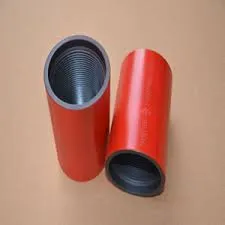tubing collar
Understanding Tubing Collars in Oil and Gas Industry
In the oil and gas industry, the term tubing collar refers to a crucial component used in the drilling and production of hydrocarbons. Tubing collars serve as connections between sections of tubing, which is a hollow cylinder that transports oil or gas from the wellbore to the surface. This article explores the significance, types, and installation procedures of tubing collars, emphasizing their role in ensuring the efficient and safe operation of oil and gas wells.
Significance of Tubing Collars
The primary function of a tubing collar is to provide a secure connection between different lengths of tubing in a well. Without tubing collars, the integrity of the tubing string could be compromised, leading to leaks, blowouts, or loss of production. These collars are designed to withstand substantial pressure and environmental challenges, including the corrosive nature of the fluids being transported. As such, they are paramount in maintaining the safety and efficiency of drilling operations.
Furthermore, tubing collars often incorporate various features that enhance their function. For instance, some collars may include valves that allow for the controlled flow of fluids or facilitate the installation of downhole tools. The role of tubing collars extends beyond mere connectivity; they are integral to the overall design and functionality of the production system.
Types of Tubing Collars
There are several types of tubing collars employed in the oil and gas industry, each designed for specific applications. The most common types include
1. Threaded Collars These are designed with threaded ends that allow for easy assembly and disassembly. Threaded collars are often used in environments where frequent maintenance or replacement of tubing is necessary.
2. Welded Collars In applications requiring high strength and resistance to pressure, welded collars are the preferred choice. These collars are welded to the tubing, creating a permanent and durable connection that can endure harsh conditions.
3. Slip-type Collars These collars are designed to fit over the ends of two tubing sections, using slips to create a secure grip. They allow for a quick and effective method of connecting tubing without the need for threading or welding.
4. Crossover Collars These specialized collars allow for the transition between different sizes or types of tubing. They are particularly useful in situations where the pressure or flow requirements change throughout the well.
tubing collar

5. Screw-on Collars These collars provide a secure connection through a screwing mechanism, often featuring O-ring seals to prevent leaks. They are favored for their ease of installation and reliability.
Installation Procedures
The installation of tubing collars is a critical process that requires careful handling to ensure safety and efficiency. The typical installation procedure involves several key steps
1. Preparation Before installation, it’s essential to inspect both the tubing and the collars for any signs of damage or wear. Proper tools and safety equipment should be at hand.
2. Alignment The open ends of the tubing sections must be aligned correctly with the tubing collar to ensure a proper fit. Misalignment can lead to inadequate sealing and potential failures.
3. Connection Depending on the type of collar being used, the connection process will vary. For threaded collars, this may involve hand-tightening and the use of a wrench to secure the connection. For welded collars, proper welding techniques must be followed to ensure a robust bond.
4. Testing Once the collars are installed, it’s critical to test the connections for leaks. This step usually involves pressurizing the tubing to monitor for any signs of failure.
5. Final Inspection Conducting a comprehensive final inspection ensures that all components are securely in place and functioning as intended before the well is brought into production.
Conclusion
In conclusion, tubing collars play an essential role in the design, construction, and operation of oil and gas wells. Their ability to provide secure and reliable connections within the tubing string is vital for maintaining the efficiency and safety of hydrocarbon extraction processes. With several types available to suit various applications and installation procedures that emphasize precision, tubing collars represent a critical component of modern oil and gas operations. As the industry continues to advance, innovations in tubing collar technology will likely enhance their performance and reliability, contributing to safer and more efficient energy production.
-
Choosing the Right Pup Joint Manufacturers for Oil and Gas OperationsNewsAug.22,2025
-
Tubing Coupling: The Small Connector with a Big ImpactNewsAug.22,2025
-
Tubing Crossover: The Essential Connector for Well IntegrityNewsAug.22,2025
-
Precision Flow Control in Well CompletionsNewsAug.22,2025
-
Casing Pup Joint for Optimal Well PerformanceNewsAug.22,2025
-
Reliable Connections with Wholesale Finished Casing CouplingNewsAug.22,2025







